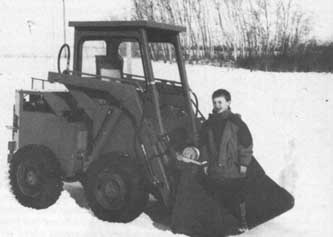
"It works better than a conventional skid steer loader," says Jack Zulkoskey, Prince Albert, Sask., about his articulated mini loader tractor that looks like a conventional skid steer at first glance but has a number of unusual features.
The tractor is divided into two parts with a single hydraulic cylinder between the two halves that bends them back and forth for steering, controlled by a hydraulic valve in the cab.
"The main benefit of this design, as compared to a normal skid steer, is that it doesn't dig up the soil when turning," notes Zulkoskey.
The basic frame was made from 5 by 3 1/2-in. by 3/8-in. angle iron. Front and back halves of the frame are joined by a 1 1/2-in. dia. pin that allows the driveshaft to run from the engine in back to the two transmissions in front. One transmission is used for speed selection and the other to run in forward or reverse.
The tractor mounts on two Ford Comet automotive differentials which were narrowed up to 44 in. "These differentials are strong and quite easy to shorten up. I flipped the rear differential over to make it run in the opposite direction so it could be connected directly to the front differential. I also mounted the rear differential on leaf springs to add flexibility and improve traction.
"The tractor's powered by an 18-R Toyota 4-cyl. engine which has a hydraulic clutch that allows the operator to control it with a hand lever from the cab. The bucket cylinders are operated by foot pedals which are connected by rods and cams to hydraulic valves under the seat. As a safety feature, the pedals can be locked in a neutral position before entering or exiting.
"In an effort to control vibration and noise, I mounted the cab on rubber isolators and mounted the motor on its original rubber mountings. When side panels are removed the engine is completely exposed for ease of maintenance.
"One drawback of the design is that it can be difficult to drive in a straight line because of the tendency to over steer."
